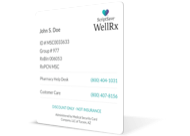Copyright 2024
Medical Security Card Company, LLC
All Rights Reserved
WellRx will never sell your personal information. Period. By signing up I agree to WellRx's terms of use and privacy policy.
By Jordan Stachel, MS, RDN
January 31, 2023
Osteopenia and osteoporosis are two very common medical conditions, with osteopenia affecting around 34 million Americans and osteoporosis affecting about 54 million Americans. Receiving a diagnosis of either condition can feel concerning. Read this article to learn about each condition and how to manage them to live a long, strong, and healthy life.
Osteopenia is a condition that often precedes osteoporosis, meaning that it can often be diagnosed before a diagnosis of osteoporosis is given. If osteopenia worsens, it turns into osteoporosis. Osteopenia refers to the weakening of one’s bones that leads to a loss of bone mineral density (BMD).
If you have a smaller amount of minerals in your bones, like calcium, the bones can become weaker and be more susceptible to breaking. This is important, as brittle and/or weak bones and an increased risk of fracture can be very dangerous for elderly people or people who may not recover as easily from fractures. Women are considered to be at a higher risk for both osteoporosis and osteopenia than men.
To determine if you have osteopenia, a dual-energy x-ray absorptiometry (DEXA) scan is performed by a qualified healthcare practitioner. This painless scan measures how much mineral is present in the bone. The measurements are reported as a metric known as a “T-score,” which is then categorized by a healthcare provider.
If your T-score is within -1 to -2.5, it is considered to be indicative of osteopenia. The lower the score, the fewer minerals there are in the bone, or the more severe the osteopenia is considered to be. Scores below -2.5 are considered to be indicative of osteoporosis.
Osteoporosis literally translates to “porous bones,” meaning that the bones have holes due to a lack of minerals. This condition is more severe than osteopenia, meaning that even fewer minerals are present in the bone. This makes the bones very weak, increasing one’s risk of breaking bones or having fractures.
Similarly to osteopenia, osteoporosis is typically diagnosed using a DEXA scan. It can be tricky to diagnose because, typically, people do not experience symptoms when they have osteoporosis. If anything, people may notice a loss of height, a change in their posture, an increased frequency of bone fractures, and/or pain in the low back.
Once a woman reaches the age of 65 and a man reaches 70, they should typically get a DEXA scan. However, osteopenia and osteoporosis can develop earlier and should be discussed with your healthcare provider for a more proactive approach.
An individual may develop osteopenia or osteoporosis for many reasons, the most common being things that disrupt and/or affect bone density, including:
While this is not an exhaustive list of reasons why someone may be at a higher risk of osteopenia and osteoporosis, they are some of the most common culprits.
You should consider many options when talking about how to prevent the development of osteopenia and osteoporosis. All of these preventative measures lie at the root of preventing bone mineral loss. Some measures to focus on include:
Overall, prevention boils down to trying to maintain a healthy, balanced lifestyle with both diet and movement.
If you have been given a diagnosis of either osteopenia and/or osteoporosis, it can be worrisome. The good news is that many treatments can help you live a long, healthy, and strong life with these conditions.
For osteopenia, treatment often begins by examining your diet and lifestyle. If your practitioner identifies that you are deficient in calcium and/or vitamin D, they may suggest supplementation to help correct any deficiencies that may exist. As a general rule of thumb, trying to get around 1200 milligrams of calcium daily and around 800-1000 International Units of vitamin D daily is a helpful starting point. Additionally, limiting alcohol and avoiding smoking is also helpful.
Next, a healthcare practitioner may talk with you about your movement routine. Trying to get some form of exercise daily is very important. If this feels overwhelming, start small. Use these tips to try to incorporate more movement into your day-to-day:
While movement will not cure osteopenia, it is essential for living with either condition and maximizing health and longevity.
For osteoporosis, the treatment also includes diet and exercise but typically medications as well. Several types of medications can be used, including hormone replacement, bisphosphonates (drugs that help with preserving bone tissue), biologics (drugs that help stop the bone from removing cells), and anabolic agents (drugs that help the body build bone).
Overall, hearing that you have osteopenia and/or osteoporosis can feel disheartening. Not to worry—you can take steps to help strengthen your body and your bones so that you feel strong for many years to come. If you know that you may be at a higher risk for developing one of these conditions, it is never too late to start prioritizing your bone health.
Jordan Stachel holds a Master’s degree in Nutrition and Dietetics from The University of Southern California and is a Registered Dietitian Nutritionist. She has several years of experience helping clients reach their health goals through her clinical work within private practice. Jordan is most fulfilled when guiding others towards making stepwise, sustainable changes that add up to big results over time. Jordan works with a wide variety of individuals, ranging in age from children through the elderly, with an assortment of concerns and clinical conditions. She helps individuals optimize overall health and/or manage disease states using personalized medical nutrition therapy techniques.
References:

For your convenience, use the ScriptSave® WellRx mobile app. Now savings are well in hand, right at the pharmacy counter. Save on your family's prescription medicines.
Learn More
Your choice. Get a ScriptSave WellRx Savings Card. Or Download the free mobile app from the App Store or Google Play Store
Get A Card
ScriptSave WellRx Grocery Guidance leverages leading-edge nutritional data science to help you know which food products on your grocery store shelf are truly good for YOU.
Healthy Foods For YouTags:

November 07, 2024

October 23, 2024

May 07, 2024
You need to log into the site to use this feature
This feature requires registration. Sign up or log in to your free WellRx account to gain access to this and other tools to help make managing your medications and wellness easier.
Benefits Include:
 Store & manage your medication list
Store & manage your medication list
 Medication pricing updates
Medication pricing updates
 Medication information
Medication information
 Pill & refill reminders
Pill & refill reminders
 Medication journal & mood log
Medication journal & mood log
This feature requires registration. Sign up or log in to your free WellRx account to gain access to this and other tools to help make managing your medications and wellness easier.
Benefits Include:
 Store & manage your medication list
Store & manage your medication list
 Medication pricing updates
Medication pricing updates
 Medication information
Medication information
 Pill & refill reminders
Pill & refill reminders
 Medication journal & mood log
Medication journal & mood log
You will be redirected to your program in 5 seconds.
Our Terms and Conditions and Privacy Policy have recently been updated.
By declining you will be logged out of your account